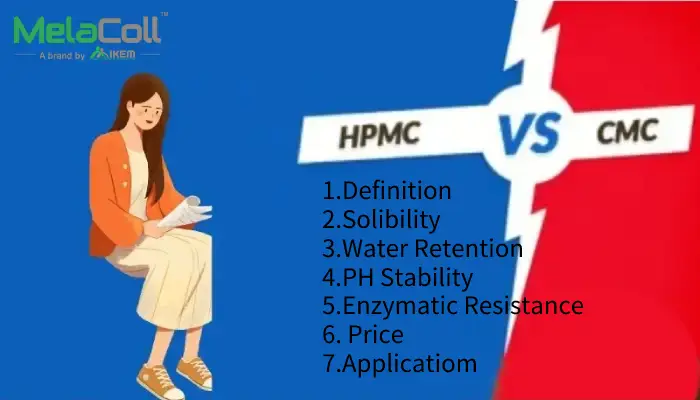
Se non distinguete HPMC e CMC, ci sono 7 differenze che dovete conoscere. HPMC vs CMC: le loro differenze si concentrano principalmente su definizione, solubilità, ritenzione idrica, stabilità al pH, resistenza enzimatica, prezzo e applicazione.
No.1 HPMC VS CMC: definizione diversa
L'HPMC viene preparato facendo reagire la cellulosa alcalina con clorometano e ossido di propilene. Questo processo avviene principalmente su eterificazione dell'officina. La carbossimetilcellulosa (CMC) è un derivato della cellulosa formato dalla reazione di alcali e acido cloroacetico.

N0,2 diversa solubilità
L'HPMC si scioglie facilmente in acqua fredda e può essere difficile da sciogliere in acqua calda. La CMC, invece, si scioglie facilmente in acqua calda e fredda e la solubilità dell'HPMC in acqua fredda è superiore a quella della CMC.

N. 3 ritenzione idrica diversa
L'HPMC ha una migliore ritenzione idrica rispetto alla CMC. Questa è la loro grande differenza.
N. 4 Stabilità del PH differente
Il Melacoll™ HPMC rimane stabile nell'intervallo di pH 3~11. Tuttavia, il PH ha un grande effetto sulla CMC, che viene utilizzata principalmente nel gesso piuttosto che nel cemento.
In un ambiente fortemente alcalino, la viscosità della CMC viene meno. Ma l'HPMC accelera la sua velocità di dissoluzione e aumenta la sua viscosità.
N. 5 diverse resistenze enzimatiche
L'HPMC ha una migliore resistenza agli enzimi rispetto alla CMC, quindi la soluzione di HPMC è meno facilmente degradabile dagli enzimi.
No.6 prezzo diverso
Il prezzo dell'HPMC è evidentemente più alto di quello della CMC.
N. 7 applicazioni diverse
La CMC si applica principalmente all'industria alimentare, ai dentifrici, alle pillole dietetiche, ai rivestimenti a base d'acqua, ai detergenti e ad altri settori. La CMC si è dimostrata un'alternativa valida e superiore all'HPMC come soluzione goniometrica. Le applicazioni più comuni dell'HPMC comprendono, tra l'altro, adesivi per piastrelle, vernici e rivestimenti, prodotti a base di gesso, stucchi, alimenti, cosmetici, detergenti e colliri.
Questa è la differenza tra HPMC e CMC. Tuttavia, qualunque sia il prodotto, il suo impatto è importante. Se si vuole conoscere Differenza tra HPMC e MHEC, fare clic qui.


Lascia una risposta